Example 1: Print a range of columns from a command output
The following command will print the second, third, and fourth columns from the command output, ‘ls -l‘. Here, the column numbers are stated explicitly, but a more efficient command for printing the same range of columns is shown in the next example.
The following output is produced by the command above.
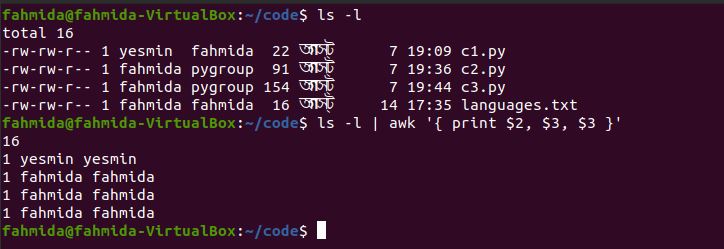
Example 2: Print the range of columns from a file by using a for loop
To follow along with this example and the other examples in this tutorial, create a text file named marks.txt with the following content:
1109 78 87 79
1167 67 81 70
1190 56 61 69
1156 89 55 78
199 54 66 58
The following `awk` command will print the first three columns of marks.txt. The for loop is used to print the column values, and the loop includes three steps. The NF variable indicates the total numbers of fields or columns of the file.
$ awk '{for(i=1;i<=NF-1;i++) printf $i" "; print ""}' marks.txt
The following output will be produced by running the command. The output shows the student IDs and the marks for CSE203 and CSE102.
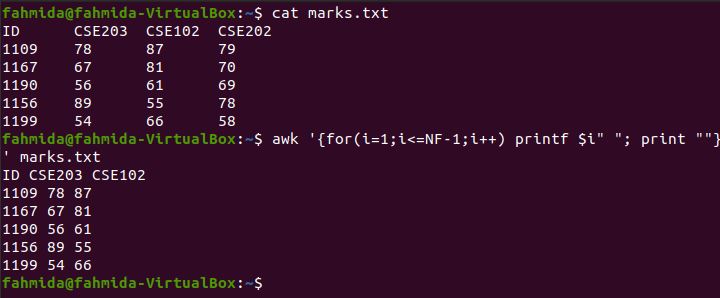
Example 3: Print the range of columns by defining starting and ending variables
The following `awk` command will print the first three columns from the command output ‘ls -l’ by initializing the starting and ending variables. Here, the value of the starting variable is 1, and the value of the ending variable is 3. These variables are iterated over in a for loop to print the column values.
{ for (i = first; i < last; i++) { printf("%s ", $i) } print $last }'
The following output will appear after running the command. The output shows the first three column values of the output, ‘ls -l’.
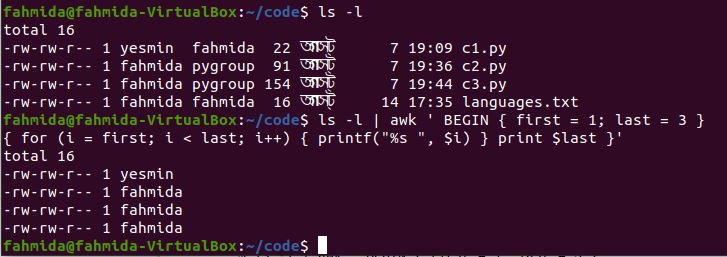
Example 4: Print a range of columns from a file with formatting
The following `awk` command will print the first three columns of marks.txt using printf and output field separator (OFS). Here, the for loop includes three steps, and three columns will be printed in sequence from the file. OFS is used here to add space between columns. When the counter value of the loop (i) equals the ending variable, then a newline(\n) is generated.
$ awk -v start=1 -v end=3 '{ for (i=start; i<=end;i++) printf("%s%s",
$i,(i==end) ? "\n" : OFS) }' marks.txt
The following output will be generated after running the above commands.
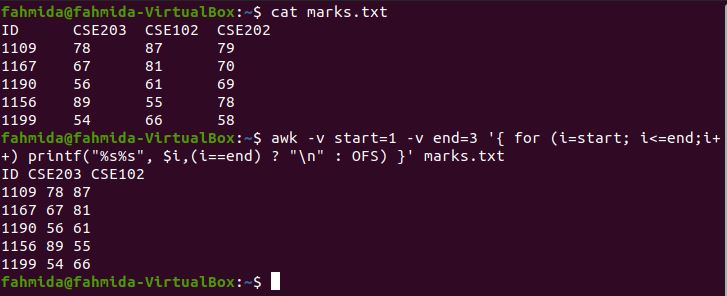
Example 5: Print the range of columns from a file using a conditional statement
The following `awk` command will print the first and last columns from a file by using a for loop and an if statement. Here, the for loop includes four steps. The starting and ending variables are used in the script to omit the second and third columns from the file by using the if condition. The OFS variable is used to add space between the columns, and the ORS variable is used to add a newline(\n) after printing the last column.
$ awk -v start=2 -v end=3 '{ for (i=1; i<=NF;i++)
if( i>=start && i<=end) continue;
else printf("%s%s", $i,(i!=NF) ? OFS : ORS) }' marks.txt
The following output will appear after running the above commands. The output shows the first and last columns of marks.txt.
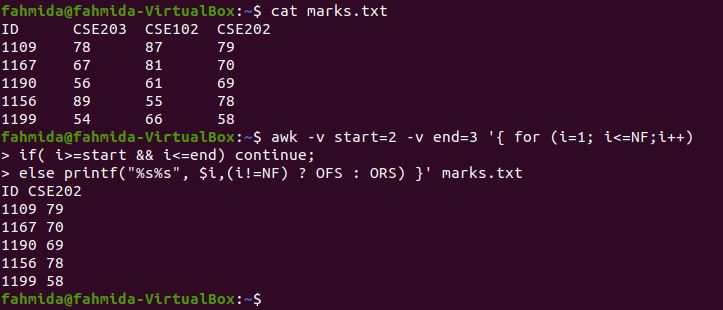
Example 6: Print the range of columns from a file using the NF variable
The following `awk` command will print the first and last columns from the file by using an NF variable. No loops or conditional statements are used to print the column values. NF indicates the number of fields. There are four columns in marks.txt. $(NF-3) defines the first column, and $NF indicates the last column.
$ awk '{print $(NF-3)" "$NF}' marks.txt
The following output is produced by running the above commands. The output shows the first and last columns of marks.txt.

Example 7: Print the range of columns from a file using substr() and index()
The index() function returns a position if the second argument value exists in the first argument value. The substr() function can take three arguments. The first argument is a string value, the second argument is the starting position, and the third argument is the length. The third argument of substr() is omitted in the following command. Because the column starts from $1 in the `awk` command, the index() function will return $3, and the command will print from $3 to $4.
$ awk '{print substr($0,index($0,$3))}' marks.txt
The following output will be produced by running the above commands.
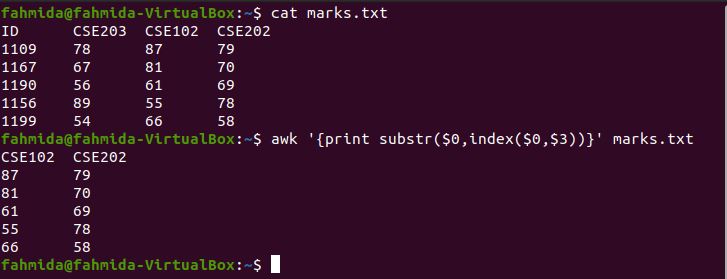
Example 8: Sequentially print a range of columns from a file using printf
The following `awk` command will print the first, second, and third columns of marks.txt by setting enough space for 10 characters.
$ awk '//{printf "%10s %10s %10s\n",$1,$3,$2 }' marks.txt
The following output will be produced by running the above commands.
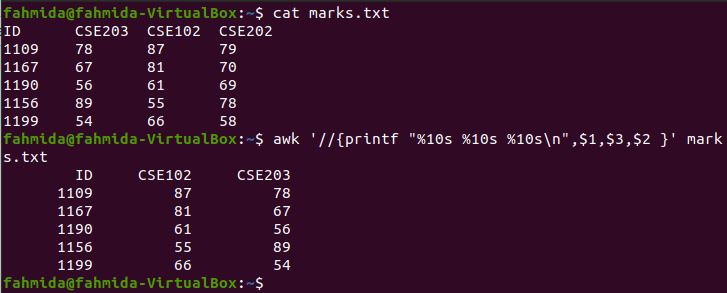
Conclusion
There are various ways to print the range of columns from the command output or a file. This tutorial shows how `awk` command can help Linux users to print content from tabular data.
from Linux Hint https://ift.tt/3n0HtTt




0 Comments